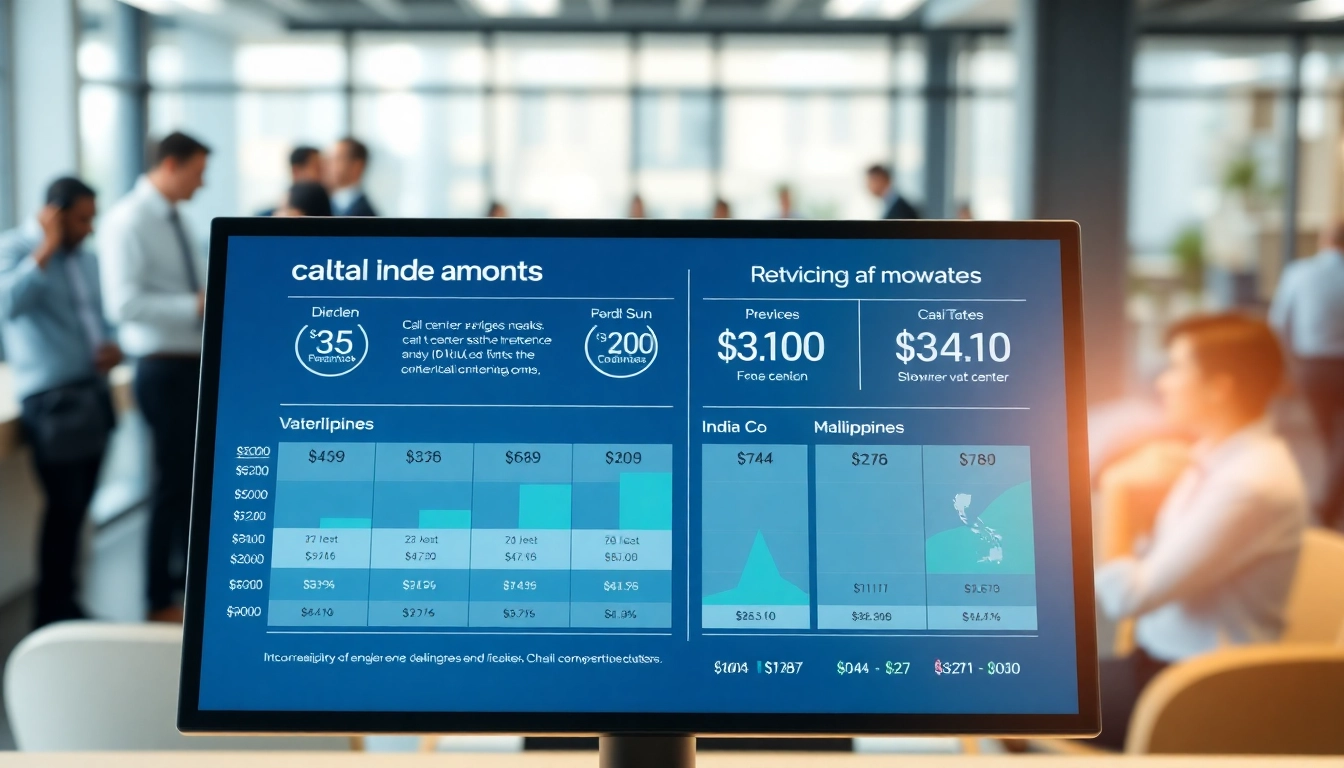Understanding Call Center Pricing Structures
The landscape of call center pricing is diverse and complex, driven by factors ranging from geographical location to the types of services offered. Businesses looking to partner with a call center often find themselves navigating a labyrinth of pricing models and service offerings. Understanding these structures is vital to ensuring operational efficiency and managing costs. This comprehensive guide will detail the various Call Center Pricing models available in the industry.
Overview of Common Pricing Models
The world of call center pricing can largely be categorized into a few common models, each with its own advantages and challenges. Understanding these models is crucial for businesses aiming to make informed decisions about outsourcing customer service or telemarketing efforts.
Hourly Pricing
Hourly pricing is one of the most straightforward models. In this framework, businesses pay a flat rate for each hour an agent works. Pricing typically ranges from $20 to $60 per hour based on the agent’s location, skillset, and the complexity of the services provided. This model suits companies that prefer predictable monthly costs and have a steady volume of calls.
Per Call Pricing
Another popular pricing model is per-call pricing, where businesses are charged for each call handled. This model can range from $1 to $10 per call. It’s beneficial for businesses with fluctuating call volumes, as it allows for cost efficiency without committing to a base fee.
Per Minute Pricing
In per-minute pricing, companies are charged based on the total time an agent spends on calls. Rates often decrease as call volume increases. For instance, initial rates may be as high as $1.50 per minute but can fall to $0.75 as usage grows.
Performance-Based Pricing
This model ties costs to the performance of the calls managed by the center. For instance, a company might pay a base fee plus bonuses for upselling or maintaining customer satisfaction standards. This incentivizes the call center to prioritize quality service.
Factors Influencing Call Center Pricing
Numerous factors affect how call centers determine their prices. Understanding these can help businesses negotiate better rates and choose the right provider.
Location
The geographical location of a call center has a profound impact on pricing. U.S.-based centers typically charge higher rates ($25–$40 per hour) than offshore alternatives in India ($6–$14 per hour) or the Philippines ($8–$12 per hour). This disparity is often influenced by the local cost of living and wage standards.
Service Complexity
The level of service required also dictates costs. Basic services such as order taking may be less expensive than advanced technical support, which requires skilled agents. Evaluating whether you need standard customer service support or specialized assistance can significantly affect your budget.
Call Volume
Higher call volumes often lead to lower per-call or per-minute rates due to economies of scale. Businesses with predictable call patterns might benefit from negotiating fixed prices based on anticipated call volumes.
Technology and Infrastructure
The technology employed by a call center can significantly influence its pricing structure. Providers using advanced CRM systems, AI-driven analytics, or other technologies may incur higher costs, which are then passed on to clients.
Comparison of Onshore vs Offshore Pricing
When evaluating call center pricing, the decision between onshore and offshore services is critical. Each option holds distinct advantages and challenges, directly impacting overall costs.
Onshore Pricing
Onshore call centers, based in the same country as the client (such as the U.S. or Canada), typically demand higher prices due to higher labor costs and operational expenditures. This pricing can range from $28 to $45 per hour depending on the complexity of services. However, the benefits of dealing in the same time zone, language, and culture can outweigh the higher costs for many businesses.
Offshore Pricing
In stark contrast, offshore call centers in countries like India and the Philippines generally offer lower rates, often between $6 and $14 per hour. The savings on labor costs can be significant, enabling businesses to allocate funds elsewhere. However, potential downsides include language barriers, cultural differences, and time zone challenges that could impact the quality of service.
Regional Variations in Call Center Costs
Call center pricing varies significantly around the globe. Understanding these regional distinctions enables businesses to better navigate their outsourcing strategies.
Call Center Pricing in the United States
In the U.S., call center pricing can be considerably higher than in other countries, due to various factors including higher labor costs, the expense of compliance with local regulations, and investments in technology. Companies can expect to pay $25 to $45 per hour on average, depending on the service level required.
Call Center Pricing in India
India has become a hub for outsourcing services, largely due to significantly lower averages that range from $6 to $14 per hour. The cost-effectiveness combined with a skilled English-speaking workforce makes India an attractive option for businesses looking to outsource. However, it’s vital to assess service quality as not all centers maintain high standards.
Call Center Pricing in the Philippines
Philippine call centers have similar pricing to India, typically ranging from $8 to $12 per hour. They are particularly known for their cultural affinity with Western customers and a strong command of the English language. The quality of service can be very competitive, making the Philippines another favorable destination for outsourcing customer service.
Calculating Your Call Center Budget
Creating an appropriate budget for call center services involves more than just looking at hourly rates. Businesses should consider multiple factors to set a realistic budget while ensuring quality service delivery.
Setting Realistic Budget Parameters
When calculating your budget, begin with a clear understanding of your anticipated call volume and the types of services you’ll require. Factor in the minimum and maximum possible call volumes to ensure you don’t overextend your resources.
Hidden Costs in Call Center Pricing
Businesses often overlook certain hidden costs associated with call center operations. This can include initial setup fees, ongoing training programs, technology investments, and potential charges for exceeding agreed call volumes. It’s crucial to conduct a thorough evaluation of potential hidden charges before finalizing contracts.
Maximizing ROI on Call Center Investments
Maximizing your return on investment (ROI) from call center services requires performance assessment and alignment with business objectives. Regularly analyze key performance indicators (KPIs) like customer satisfaction scores, average handling times, and first-call resolution rates to ensure you’re getting the best value from your provider.
Best Practices for Choosing a Call Center Provider
The selection process for a call center provider should be detail-oriented and strategic to ensure alignment with your business goals. Here are best practices to consider during your search.
Assessing Your Business Needs
Understand your specific needs clearly before you begin the search. Determine the volume of calls, types of services required, and any industry-specific considerations that might affect your choice. By defining your requirements upfront, you can better evaluate candidates based on their ability to meet those needs.
Evaluating Service Level Agreements (SLAs)
Service Level Agreements are contracts that outline the expected levels of service, including performance metrics, responsibilities, and penalties for non-compliance. Careful evaluation of SLAs ensures that both parties have clear expectations, ultimately impacting the quality of the services delivered.
Negotiating Pricing and Terms
Don’t hesitate to negotiate. Prices are often flexible, particularly for businesses willing to commit to longer contracts or a higher volume of calls. Discuss various pricing models with potential partners to find an arrangement that fits your budget and risk tolerance.
Future Trends in Call Center Pricing
As the call center industry evolves, emerging trends continue to reshape pricing structures and service offerings. Businesses must stay ahead of these developments to maintain competitiveness.
Impact of Technology on Pricing Models
Advancements in technology are revolutionizing call center operations, allowing for more efficient pricing models. Automation through AI and machine learning is leading to reduced operational costs and faster service delivery. These technologies can lead to lower prices for clients as the efficiency improves.
How Outsourcing Will Shape Call Center Costs
Outsourcing remains a significant trend influencing call center pricing. As more companies shift services offshore to take advantage of lower costs, this increased competition could drive prices down, benefitting end-users. However, businesses should also consider the potential trade-offs in service quality.
Adapting to Changes in Consumer Expectations
As customer expectations continue to evolve toward instant, personalized service, call centers must adapt. This could mean investing in more sophisticated technology or highly trained staff, potentially affecting pricing structures as businesses strive to meet these expectations.









